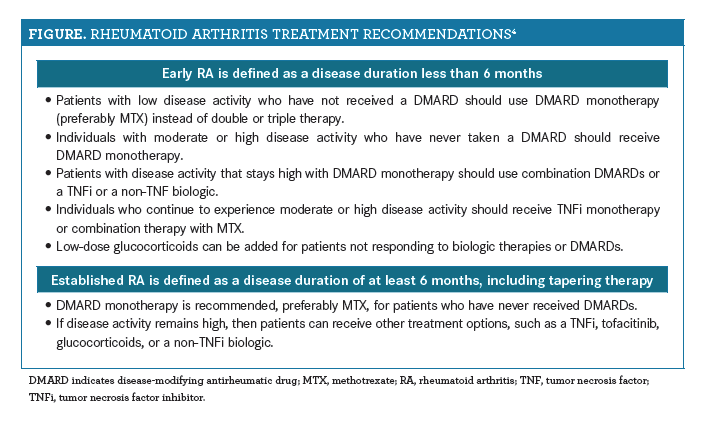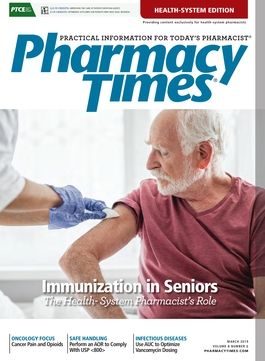Publication
Article
Pharmacy Practice in Focus: Health Systems
RA Treatment Strategies Can Keep the Pain at Bay
Author(s):
Health care providers should use the treat-to-target approach to achieve the best outcomes for rheumatoid arthritis patients.
Rheumatoid arthritis (RA) is a chronic autoimmune disease that causes joint inflammation and swelling.1 Additionally, RA can damage other nonjoint areas, including the blood vessels, eyes, heart, lungs, and skin. Risk factors for developing RA include being female, the environment (asbestos), family history, obesity, older age, and smoking.1
New Drug Approval
Olumiant (baricitinib), the newest drug to treat moderate to severe RA, was approved in May 2018.2 Olumiant is a Janus kinase inhibitor approved for patients with RA who have not responded to 1 or more tumor necrosis factor antagonist treatments, and it can be used as monotherapy or in combination with methotrexate or other disease-modifying antirheumatic drugs (DMARDs). The recommended dose is 2 mg orally once daily, and it can be given with or without food. There is a black box warning that Olumiant can increase the risk of developing serious infections, malignancies, and thrombosis. Patients should be evaluated for active or latent tuberculosis before starting treatment with Olumiant. Additionally, cases of shingles have been reported in patients taking Olumiant. If patients develop shingles, discontinue use until the condition resolves.2
Olumiant was evaluated in a 52-week phase 3 study in 1307 patients with active RA who were receiving methotrexate.3 Patients were randomly assigned to 1 of 3 treatment groups: 4-mg Humira (adalimumab) every other week, 4-mg Olumiant once daily, or placebo (switched to Olumiant after 24 weeks). The study results showed that Olumiant was associated with significant clinical improvement compared with Humira (P = .014) and placebo (P <.001).3
Treatment Considerations
Treatment for RA has changed significantly over the past 30 years, as effective and novel therapies have become available.4 The treat-to-target principle is considered the gold standard for treating patients with RA.4 This principle involves setting a therapeutic goal and working with patients to achieve the best outcomes. The American College of Rheumatology guidelines include recommendations for patients with early and established RA/ (see figure).4

DMARD treatments include hydroxychloroquine, leflunomide, methotrexate, and sulfasalazine; they act slowly, only after the drug has been taken for several weeks.4 Methotrexate is generally considered the DMARD of choice for initial therapy. It is important to ensure that patients receiving DMARDs have laboratory monitoring that includes complete blood count, liver transaminase levels, and serum creatinine.4
Biologic treatments include medications such as adalimumab, etanercept (Enbrel), infliximab (Remicade), and tofacitinib (Xeljanz); these work faster and are sometimes better tolerated than the DMARDs.4,5 However, biologics carry the risk of lymphoma and tuberculosis.5 If corticosteroids are part of the treatment plan, then it is important to ensure that they are used at the lowest possible dose for the shortest duration. Corticosteroid adverse effects include infection, increased blood glucose, osteoporosis, and weight gain.5 Additionally, it is important for patients to be up-to-date on vaccines, including hepatitis B, influenza, pneumococcal, and zoster (shingles).4 Individuals aged 19 to 64 years with RA who are receiving immunosuppressive drugs, such as Humira, should receive the pneumococcal conjugate vaccine.6
Jennifer Gershman, PharmD, CPh, is a drug information pharmacist and Pharmacy Times contributor who resides in South Florida.
References
- Rheumatoid arthritis. Mayo Clinic website. mayoclinic.org/diseases-conditions/rheumatoid-arthritis/symptoms-causes/syc-20353648. Accessed January 13, 2019.
- Olumiant [prescribing information]. Indianapolis, IN: Eli Lilly and Co; 2018.uspl.lilly.com/olumiant/olumiant.html#pi. Accessed January 13, 2019.
- Taylor PC, Keystone EC, van der Heijde D, et al. Baricitinib versus placebo or adalimumab in rheumatoid arthritis. N Engl J Med. 2017;376(7):652-662. doi:10.1056/NEJMoa1608345.
- Singh JA, Saag KG, Bridges SL Jr, et al. 2015 American College of Rheumatology guideline for the treatment of rheumatoid arthritis. Arthritis Rheumatol. 2016;68(1):1-26. doi: 10.1002/art.39480.
- Rheumatoid arthritis: how to treat. Cleveland Clinic website. my.clevelandclinic.org/health/drugs/4750-rheumatoid-arthritis-how-to-treat. Updated January 11, 2018. Accessed January 17, 2019.
- Pneumococcal vaccines (PCV13 and PPSV23). Immunization Action Coalition website. immunize.org/askexperts/experts_pneumococcal_vaccines.asp. Updated November 26, 2018. Accessed January 17, 2019.






